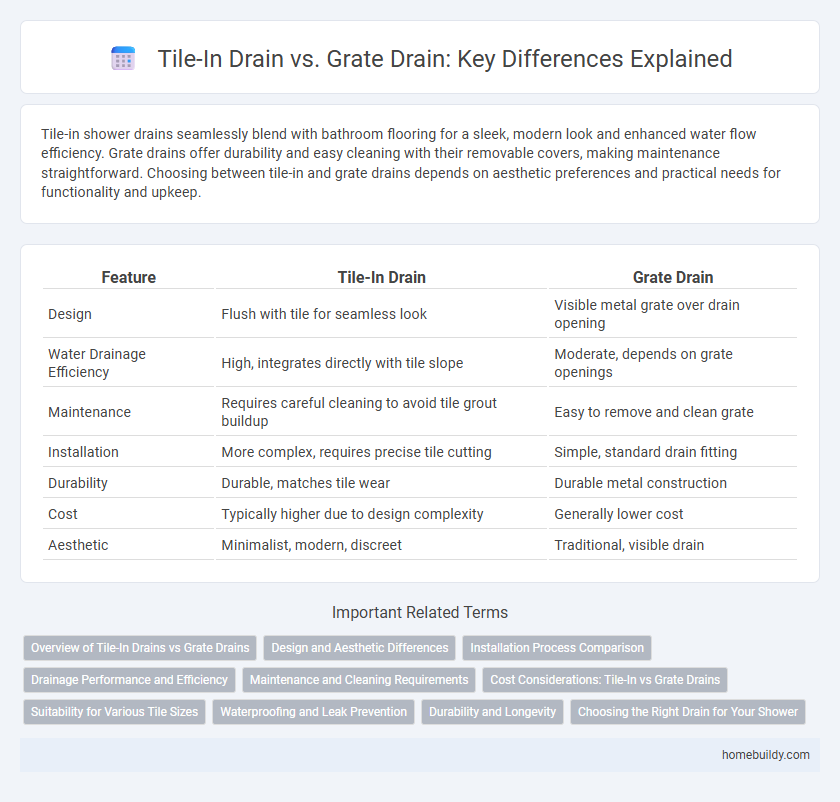Tile-in shower drains seamlessly blend with bathroom flooring for a sleek, modern look and enhanced water flow efficiency. Grate drains offer durability and easy cleaning with their removable covers, making maintenance straightforward. Choosing between tile-in and grate drains depends on aesthetic preferences and practical needs for functionality and upkeep.
Table of Comparison
| Feature | Tile-In Drain | Grate Drain |
|---|---|---|
| Design | Flush with tile for seamless look | Visible metal grate over drain opening |
| Water Drainage Efficiency | High, integrates directly with tile slope | Moderate, depends on grate openings |
| Maintenance | Requires careful cleaning to avoid tile grout buildup | Easy to remove and clean grate |
| Installation | More complex, requires precise tile cutting | Simple, standard drain fitting |
| Durability | Durable, matches tile wear | Durable metal construction |
| Cost | Typically higher due to design complexity | Generally lower cost |
| Aesthetic | Minimalist, modern, discreet | Traditional, visible drain |
Overview of Tile-In Drains vs Grate Drains
Tile-in drains offer a seamless, customizable finish by integrating the surrounding tile into the drain cover, enhancing bathroom aesthetics and reducing slip hazards. Grate drains feature a removable metal or plastic cover with perforations, providing easy access for cleaning and robust water drainage. Choice between tile-in and grate drains depends on design preference, maintenance needs, and slip resistance requirements.
Design and Aesthetic Differences
Tile-in drains seamlessly integrate with shower flooring by allowing tiles to continue over the drain surface, creating a sleek, minimalist appearance that enhances modern bathroom designs. Grate drains feature visible metal or plastic covers with patterned openings, offering a more traditional look that can complement both classic and industrial-style bathrooms. The choice between tile-in and grate drains significantly impacts the overall aesthetic, with tile-in providing a flush, monochromatic finish, while grate drains introduce textural contrast and design versatility.
Installation Process Comparison
Tile-in shower drains integrate seamlessly with the surrounding tile, requiring precise alignment and careful waterproofing to create a flush, custom look that enhances bathroom aesthetics. Grate drains offer a simpler installation process, involving standard fitting onto the shower base with a removable grate cover for easy maintenance but lack the fully integrated appearance. Choosing between tile-in and grate drains involves balancing installation complexity, design preferences, and long-term maintenance needs.
Drainage Performance and Efficiency
Tile-in drains offer superior drainage performance by seamlessly integrating with the shower floor, allowing water to flow more efficiently into the drain without obstruction. Grate drains, while easier to install, can sometimes cause water pooling due to their raised grate design that may trap debris and reduce flow rate. The tile-in drain's continuous surface minimizes clogs and ensures faster water evacuation, enhancing overall shower efficiency.
Maintenance and Cleaning Requirements
Tile-in drains require more meticulous cleaning to prevent grout buildup and maintain a seamless appearance, as they integrate flush with the shower floor. Grate drains offer easier maintenance with removable covers allowing quick access to clear hair and debris, reducing clog risks. Both types need regular inspection, but tile-in drains demand more specialized care due to their integrated design.
Cost Considerations: Tile-In vs Grate Drains
Tile-in drains often require higher installation costs due to the need for precise tile cutting and waterproofing to ensure seamless integration with shower flooring. Grate drains typically offer a more budget-friendly option with simpler installation, but may lack the customized aesthetic that tile-in drains provide. When considering long-term maintenance, tile-in drains can incur additional expenses for tile replacement or repairs if damaged, whereas grate drains allow for easier cleaning and part replacement, influencing overall cost efficiency.
Suitability for Various Tile Sizes
Tile-in drains offer seamless integration for various tile sizes by allowing the tile to sit flush with the drain surface, creating a uniform and visually appealing finish. Grate drains, while compatible with a range of tiles, may not accommodate smaller or irregularly shaped tiles as effectively due to their fixed grate patterns. Choosing between tile-in and grate drains depends on the specific tile dimensions and the desired aesthetic continuity in the shower design.
Waterproofing and Leak Prevention
Tile-in drains offer superior waterproofing and leak prevention by creating a seamless integration with the shower tile, minimizing gaps where water can escape. Grate drains, while easier to install, often rely on additional sealing methods that may degrade over time, leading to potential leaks. Proper waterproofing membranes paired with tile-in drains enhance durability and reduce maintenance issues associated with water damage.
Durability and Longevity
Tile-in drains offer superior durability and longevity due to their seamless integration with tile surfaces, reducing the risk of corrosion and wear over time. Grate drains, often made from stainless steel or plastic, may be prone to damage or rust, especially in high-moisture environments. Proper installation and material quality significantly impact the lifespan of both tile-in and grate shower drains.
Choosing the Right Drain for Your Shower
Tile-in drains offer a seamless, customizable finish by allowing the shower tile to blend directly into the drain cover, enhancing aesthetic appeal and minimizing water pooling. Grate drains, usually made of metal or plastic, provide robust durability and easier maintenance, making them suitable for heavier water flow and frequent cleaning needs. Selecting the right shower drain depends on balancing design preferences with functionality, ensuring proper water drainage while complementing the overall bathroom style.
Tile-in drain vs grate drain Infographic

 homebuildy.com
homebuildy.com